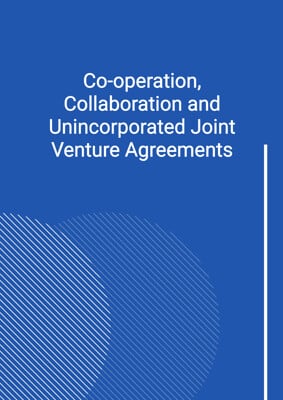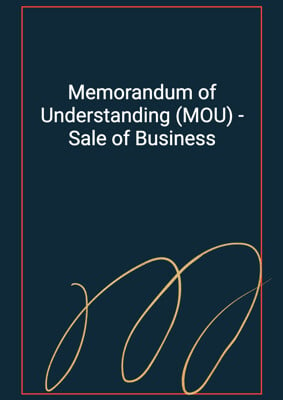How to Tailor the Document for Your Need?
01
Create Document
Fill in the details of the parties. You can click the "Fill with Member’s Information" button to complete it with information saved to your account.
02
Fill Information
Please fill in any additional information by following the step-by-step guide on the left hand side of the preview document and click the "Next" button.
03
Get Document
When you are done, click the "Get Document" button and you can download the document in Word or PDF format.
04
Review Document
Please get all parties to review the document carefully and make any final modifications to ensure that the details are correct before signing the document.
Document Preview
Document Description
The document titled 'Letter of Intent (LOI) - Joint Venture (Simple)' is a letter of intent between two parties, Party 1 and Party 2, who intend to form a joint venture company. The purpose of this letter of intent is to outline the current understanding of the parties regarding the proposed joint venture and provide a basis for the preparation of a feasibility study report, a joint venture contract, and articles of association.
The document begins with a brief introduction stating the intention of Party 1 and Party 2 to negotiate and establish an equity joint venture company. It highlights the importance of this letter of intent in setting forth the current understanding of the parties and providing a basis for further discussions and agreements.
The document is divided into several sections, each addressing a specific aspect of the joint venture. The sections include:
1. Form and Name of the JVC: This section outlines that the joint venture company will be a limited liability company formed in accordance with the laws of the country and will be named 'JVC'.
2. Purpose of the JVC: This section states that the purpose of the joint venture will be the sourcing, manufacture, distribution, and sale of a specific product and related raw materials, as well as other activities agreed upon by the parties.
3. Business Scope and Scale of the JVC: This section specifies that the products and production scale of the joint venture will be determined by the board of directors and that the initial capacity will be approximately a certain quantity per year.
4. Total Investment and Registered Capital: This section mentions the estimated total investment and registered capital of the joint venture and states that the exact amounts will be defined in the joint venture contract.
5. Form of Investment: This section describes the contributions of Party 1 and Party 2 to the joint venture. It outlines different scenarios based on whether Party 1 or Party 2 will contribute an existing plant and facilities or cash for completing the construction of the plant.
6. Land: This section addresses the land-use rights for the site of the plant. It specifies whether Party 1 or Party 2 has obtained the land-use rights and whether the rights will be contributed or leased to the joint venture.
7. Loans: This section mentions that the parties will investigate the feasibility of funding part of the joint venture's requirements through loans and that if loans are obtained, they will be borrowed in the name of the joint venture.
8. Increases in Registered Capital: This section states that if the board of the joint venture decides to expand in the future and increase the registered capital, each party will have the option to increase its contribution proportionally.
9. Profit Sharing: This section explains that profits will be distributed to the parties in proportion to their share of the registered capital of the joint venture.
10. Sales: This section states that the joint venture will sell its products in the domestic or international market as decided by the board.
11. Management: This section outlines the governance structure of the joint venture, with the board of directors being the governing body responsible for making major decisions. It mentions the appointment of directors by each party and equal voting rights.
12. Confidentiality: This section emphasizes the importance of keeping all information, documents, and data disclosed by the parties strictly confidential, except for the establishment of the joint venture.
13. Term (if applicable): This section specifies the duration of the joint venture and mentions that the parties will negotiate the terms of its extension, if necessary.
14. Next Steps: This section highlights that the final terms of the joint venture contract will be subject to the approval of the parties' boards of directors. It mentions the need to conduct a feasibility study and draft a joint venture contract and articles of association.
15. Third Party Interference: This section states that the parties will negotiate in good faith and will not enter into discussions with a third party regarding a joint venture for the manufacture of products in the country before a certain period.
16. Dispute Resolutions: This section includes a jurisdiction clause and the signatures of the authorized representatives of Party 1 and Party 2.
In summary, the document provides a detailed outline of the proposed joint venture, covering various aspects such as the form and name of the joint venture, its purpose, business scope and scale, total investment and registered capital, form of investment, land-use rights, loans, profit sharing, sales, management, confidentiality, term (if applicable), next steps, third party interference, and dispute resolutions.
How to use this document?
To use the 'Letter of Intent (LOI) - Joint Venture (Simple)' document, follow these steps:
1. Review the document: Read the entire document carefully to understand its contents and purpose.
2. Customize the document: Replace the placeholders with the actual names and addresses of Party 1 and Party 2. Modify the document as necessary to reflect the specific details of your joint venture.
3. Form and Name of the JVC: Determine the form of the joint venture company and agree on a suitable name for the company.
4. Purpose of the JVC: Discuss and agree on the specific purpose of the joint venture, which may include the sourcing, manufacture, distribution, and sale of a particular product and related raw materials.
5. Business Scope and Scale of the JVC: Determine the products and production scale of the joint venture, considering factors such as market demand and feasibility.
6. Total Investment and Registered Capital: Estimate the total investment required for the joint venture and agree on the registered capital. Ensure that the exact amounts are defined in the joint venture contract.
7. Form of Investment: Decide on the contributions of each party to the joint venture, considering whether an existing plant and facilities will be contributed or cash will be used for completing the construction of the plant.
8. Land: Determine the land-use rights for the site of the plant, including whether the rights will be contributed or leased to the joint venture.
9. Loans: Evaluate the feasibility of obtaining loans to fund part of the joint venture's requirements. If feasible, explore loan options and ensure that any required security is provided.
10. Increases in Registered Capital: Discuss the possibility of future expansion and agree on the option for each party to increase its contribution to the registered capital proportionally.
11. Profit Sharing: Determine the method of profit distribution among the parties based on their share of the registered capital.
12. Sales: Decide whether the joint venture will focus on the domestic market, international market, or both.
13. Management: Establish the governance structure of the joint venture, including the composition of the board of directors and the appointment of directors by each party. Clarify the roles and responsibilities of the general manager and the board.
14. Confidentiality: Emphasize the importance of maintaining strict confidentiality regarding all information, documents, and data disclosed by the parties.
15. Term (if applicable): Determine the duration of the joint venture and discuss the possibility of extending the term.
16. Next Steps: Work together to finalize the terms of the joint venture contract and obtain the necessary approvals from the boards of directors. Conduct a feasibility study to assess the viability of the joint venture and draft the joint venture contract and articles of association.
17. Third Party Interference: Commit to negotiating in good faith and refrain from engaging in discussions with third parties regarding a similar joint venture before a certain period.
18. Dispute Resolutions: Familiarize yourself with the jurisdiction clause and ensure that the authorized representatives of both parties sign the document.
Note: This guidance provides a general overview of the steps involved in using the document. It is important to consult legal and business professionals to ensure compliance with applicable laws and regulations and to address specific requirements and circumstances.
Not the right document?
Don’t worry, we have thousands of documents for you to choose from:

























